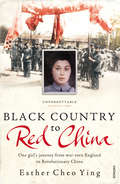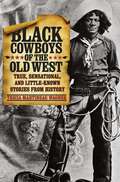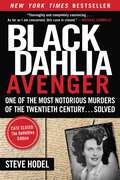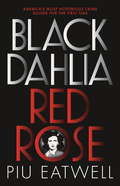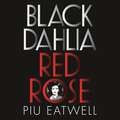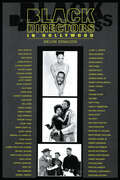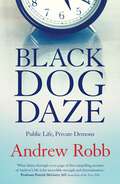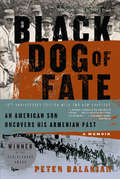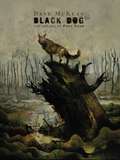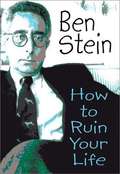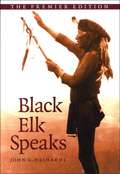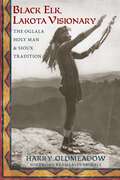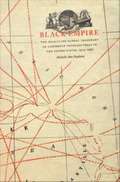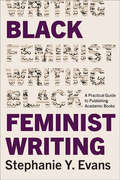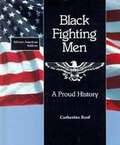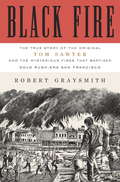- Table View
- List View
Black Country to Red China: One girl's story from war-torn England to Revolutionary China
by Esther Cheo YingBorn in pre-Revolutionary China and brought up in the Midlands, Esther Cheo Ying returned to China in 1949 after a traumatic childhood, convinced that there she would find the happiness and sense of belonging she longed for. Caught up in the turmoil of civil war and sympathetic to the Communist Revolution, she joined the Red Army and then stayed on to work in the new People's Republic. But despite her determination to make a new life in China could she truly be happy in a country which encouraged constant self-criticism and viewed her as a 'false foreign devil'? Black Country to Red China is an extraordinary account of life before the Cultural Revolution, but it is also a fascinating insight into one woman's struggle to come to terms with your own identity.
Black Cowboys of the Old West: True, Sensational, and Little-Known Stories from History
by Tricia Martineau WagnerThe word cowboy conjures up vivid images of rugged men on saddled horses—men lassoing cattle, riding bulls, or brandishing guns in a shoot-out. White men, as Hollywood remembers them. What is woefully missing from these scenes is their counterparts: the black cowboys who made up one-fourth of the wranglers and rodeo riders. This book tells their story.When the Civil War ended, black men left the Old South in large numbers to seek a living in the Old West—industrious men resolved to carve out a life for themselves on the wild, roaming plains. Some had experience working cattle from their time as slaves; others simply sought a freedom they had never known before. The lucky travelled on horseback; the rest, by foot. Over dirt roads they went from Alabama and South Carolina to present-day Texas and California up north through Kansas to Montana. The Old West was a land of opportunity for these adventurous wranglers and future rodeo champions. A long overdue testament to the courage and skill of black cowboys, Black Cowboys of the Old West finally gives these courageous men their rightful place in history.Praise for an earlier book by the same author:&“Whether you are a history enthusiast or a lover of adventure stories, African American Women of the Old Westpresents the reader with fascinating accounts of ten extraordinary, generally unrecognized, African Americans. Tricia Martineau Wagner takes these remarkable women from the footnotes of history and brings them to life.&” —Ed Diaz, President of the Association for African American Historical Research and Preservation
Black Dahlia Avenger: Case Closed: The Definitive Edition
by Steve HodelA NEW YORK TIMES BESTSELLER! THIS NEW AND UPDATED EDITION FINALLY PROVES THE SHOCKING IDENTITY OF THE BLACK DAHLIA KILLER—AND THE POLICE CORRUPTION THAT CONCEALED IT FOR SO LONGIn 1947, the brutal, sadistic murder of a beautiful young woman named Elizabeth Short led to the largest manhunt in LA history. The killer teased and taunted the police and public for weeks, but his identity stayed a mystery, and the murder remained the most tantalizing unsolved case of the last century.Steve Hodel, a retired LAPD detective, took up the case, reviewing the original evidence and records as well as those of a separate grand jury investigation into a series of murders of single women in LA at the time. The prime suspect had in fact been identified, but never indicted. Why? And who was he?In an account that will remind movie lovers of both LA Confidential and Zodiac, for the corruption it exposes and the insight it offers into a serial killer&’s mind, Hodel demonstrates that there was a massive police cover-up. Even more shocking, he proves that the murderer, a true-life Jekyll and Hyde who was a highly respected member of society by day and a psychopathic killer by night, was his own father.This new and updated edition of the book includes an updated introduction from the author as well as new evidence and photographs to once and for all close the case on the Black Dahlia murder.
Black Dahlia, Red Rose: A 'Times Book of the Year'
by Piu Eatwell******* A TIMES 'BOOK OF THE YEAR' **********Shortlisted for the CWA Dagger for non-fiction***'A magnificent, meticulous and startling re-examination of a crime that haunts the world's imagination' Geoffrey Wansell, author of An Evil Love: The Life of Frederick West'Eatwell writes brilliantly . . . [she] has finally offered [Elizabeth] Short a type of belated justice. Her book reads like a thriller' Sunday Times'A compelling read, in both style and substance . . . A must-read for anyone with an interest in the Black Dahlia - or indeed any fan of the true-crime genre' Rod Reynolds, author of The Dark Inside'Compulsively readable, impeccably researched and heart-rending at times . . . Superb' Sarah Lotz, author of The Three and The White Road*************On 15th January 1947, the naked, dismembered body of a black-haired beauty, Elizabeth Short, was discovered lying next to a pavement in a Hollywood suburb. She was quickly nicknamed The Black Dahlia.The homicide inquiry that followed consumed Los Angeles for years and the authorities blew millions of dollars of resources on an investigation that threw up dozens of suspects. But it never was solved.Until now.In this ground-breaking book, Piu Eatwell reveals compelling forensic and eye witness evidence for the first time, which finally points to the identity of the murderer. The case was immortalised in James Ellroy's famous novel based on the case, in Kenneth Anger's Hollywood Babylon and Brian de Palma's movie The Black Dahlia.This is a dark tale of sex, manipulation, obsession, psychopathy and one of the biggest police cover ups in history.
Black Dahlia, Red Rose: A 'Times Book of the Year'
by Piu Eatwell'Eatwell writes brilliantly . . . [she] has finally offered [Elizabeth] Short a type of belated justice. Her book reads like a thriller' Sunday Times'A compelling read, in both style and substance . . . A must-read for anyone with an interest in the Black Dahlia - or indeed any fan of the true-crime genre' Rod Reynolds, author of The Dark Inside'Compulsively readable, impeccably researched and heart-rending at times . . . Superb' Sarah Lotz, author of The Three and The White Road*************On 15th January 1947, the naked, dismembered body of a black-haired beauty, Elizabeth Short, was discovered lying next to a pavement in a Hollywood suburb. She was quickly nicknamed The Black Dahlia.The homicide inquiry that followed consumed Los Angeles for years and the authorities blew millions of dollars of resources on an investigation that threw up dozens of suspects. But it never was solved.Until now.In this ground-breaking book, Piu Eatwell reveals compelling forensic and eye witness evidence for the first time, which finally points to the identity of the murderer. The case was immortalised in James Ellroy's famous novel based on the case, in Kenneth Anger's Hollywood Babylon and Brian de Palma's movie The Black Dahlia.This is a dark tale of sex, manipulation, obsession, psychopathy and one of the biggest police cover ups in history. (p)2017 Hodder & Stoughton Limited
Black Diamond: The Story of the Negro Baseball Leagues
by Patricia C. Mckissack Fredrick MckissackA stirring tribute to the human drama, legendary heroes, infamous owners, low pay, and long bus rides that were the Negro Leagues. A 1995 Coretta Scott King Honor Book now in a striking Polaris edition. Copyright © Libri GmbH. All rights reserved.
Black Directors in Hollywood
by Melvin DonalsonThis book offers a first comprehensive look at the work of black directors in Hollywood, from pioneers such as Gordon Parks, Melvin Van Peebles, and Ossie Davis to current talents including Spike Lee, John Singleton, Kasi Lemmons, and Carl Franklin. Discussing 67 individuals and over 135 films, Melvin Donalson thoroughly explores how black directors' storytelling skills and film techniques have widened both the thematic focus and visual style of American cinema. Assessing the meanings and messages in their films, he convincingly demonstrates that black directors are balancing Hollywood's demand for box office success with artistic achievement and responsibility to ethnic, cultural, and gender issues.
Black Diva of the Thirties: The Life of Ruby Elzy (Willie Morris Books in Memoir and Biography)
by David E. WeaverWhile undergoing routine surgery to remove a benign tumor, Ruby Elzy died. She was only thirty-five. Had she lived, she would have been one of the first Black artists to appear in grand opera. Although now in the shadows, she was a shining star in her day. She entertained Eleanor Roosevelt in the White House. She was Paul Robeson's leading lady in the movie version of The Emperor Jones. She starred in Birth of the Blues opposite Bing Crosby and Mary Martin. She sang at Harlem's Apollo Theater and in the Hollywood Bowl. Her remarkable soprano voice was known to millions over the radio. She was personally chosen by George Gershwin to create one of the leading roles in his masterpiece, that of Serena in the original production of Porgy and Bess. Her signature song was the vocally demanding “My Man's Gone Now.” From obscurity she had risen to great heights. Ruby Pearl Elzy (1908-1943) was born in abject poverty in Pontotoc, Mississippi. Her father abandoned the family when she was five, leaving her mother, a strong, devout woman, to raise four small children. Ruby first sang publicly at the age of four and even in childhood dreamed of a career on the stage. Good fortune struck when a visiting professor, overwhelmed upon hearing her beautiful voice at Rust College in Mississippi, arranged for her to study music at Ohio State University. Later, on a Rosenwald Fellowship, she enrolled at the Juilliard School in New York City. After more than eight hundred performances in Porgy and Bess, she set her sights on a huge goal, to sing in grand opera. She was at the peak of her form. While she was preparing for her debut in the title role of Verdi's Aida, tragedy struck. During her brief career, Ruby Elzy was in the top tier of American sopranos and a precursor who paved a way for Leontyne Price, Jessye Norman, Kathleen Battle, and other black divas of the operatic stage. This biography acknowledges her exceptional talent, recognizes her contribution to American music, and tells her tragic yet inspiring story.
Black Dog Daze: Public Life, Private Demons
by Andrew RobbAndrew Robb lived with an unspoken fear that what he passed off as 'not being good in the mornings' was something darker: a black dog whose daily visit lasted longer as the years passed. Worried about stigmas and letting people down, he avoided confronting the problem for four decades, the adrenaline of high-pressure and high profile jobs offering the ideal antidote. Ultimately, realising his ambitions meant having to face up to this very private demon.Andrew Robb's battle with the black dog has touched a chord with many Australians. His memoir explores the challenges of managing depression, political ambition and life in the Liberal Party.Andrew Robb's career has been devoted to the Liberal cause—as Federal Director of the Liberal Party, as Executive Director of the National Farmers Federation, during seven years in the Packer business empire, and now in parliamentary politics. His memoirs document the private struggle and the public life of the Liberal Party's chief political strategist. It offers readers an insight into one man's lifelong battle with a private demon amidst the drama and tumult of contemporary Australian politics.
Black Dog of Fate: A Memoir
by BalakianIn this tenth anniversary edition of his award-winning memoir, New York Times bestselling author Peter Balakian has expanded his compelling story about growing up in the baby-boom suburbs of the ’50s and ’60s and coming to understand what happened to his family in the first genocide of the twentieth century—the Ottoman Turkish government’s extermination of more than one million Armenians in 1915. In this new edition, Balakian continues his exploration of the Armenian Genocide with new chapters about his journey to Aleppo and his trip to the Der Zor desert of Syria in his pursuit of his grandmother’s life, bringing us closer to the twentieth century’s first genocide.
Black Dog: The Dreams of Paul Nash
by Dave McKeanA new original graphic novel by DAVE McKEAN!Best known for his collaborations with Neil Gaiman, Dave McKean defied expectations with his stunning debut as writerand artist in Cages, winner of multiple awards for Best Graphic Album. Dark Horse proudly presents a new original graphic novel by the legendary artist based on the life of Paul Nash, a surrealist painter during World War I. The Dreams of Paul Nash deals with real soldiers&’ memoirs, and all the stories add up to a moving piece about how war and extreme situations change us and how we deal with the resultant pain—in Nash&’s case, by turning his landscapes into powerful and fantastical &“psychoscapes.
Black Eagle Child
by Ray A. Young BearStories of life on a Native American settlement during the 50s,60s and 70s. Told in poetry in prose.
Black Eagle Child: The Facepaint Narratives (Singular Lives Ser.)
by Ray Young BearMixing prose and poetry, ancient traditions and modern sensibilities, this brilliant, profane, and poignant coming-of-age story is a masterpiece of Native American literature At a Thanksgiving party held in a Bureau of Indian Affairs gymnasium, the elders of the Meskwaki Settlement in central Iowa sip coffee while the teenagers plot their escape. Edgar Bearchild and Ted Facepaint, too broke to join their friends for a night of drinking in a nearby farm town, decide to attend a ceremonial gathering of the Well-Off Man Church, a tribal sect with hallucinogenic practices. After partaking of the congregation's sacred star medicine, Edgar receives a prophetic vision and comes to a newfound understanding of his people's past and present that will ultimately reshape the course of his life. Set against the backdrop of the tumultuous 1960s, Black Eagle Child is the story of Edgar's passage from boyhood to manhood, from his youthful misadventures with Ted, to his year at prestigious liberal arts college in California, to his return to Iowa and success as a poet. Deftly crossing genre boundaries and weaving together a multitude of tones and images--from grief to humor, grape Jell-O to supernatural strobe lights--it is also an unforgettable portrait of what it means to be a Native American in the modern world.
Black Earth City: When Russia Ran Wild (And So Did We)
by Charlotte HobsonA young woman's heady encounter with the new Russia, as she and the country thrill to their first taste of freedomIt is September 1991 and the dismantling of the Soviet Union is under way. In Voronezh, a provincial town famous for its loamy black earth, a sense of lightheartedness-part fear, part exhilaration-pervades. The people conquer uncertainty, hunger, and -20 degree temperatures by drinking huge quantities of black-market vodka and reveling in their new-found sexual freedom.Black Earth City is Charlotte Hobson's record of this tumultuous time. An irresistible guide, she brings us into the cramped, rundown Hostel no. 4, where international students and locals congregate. We meet Yakov, who blows half-a-million rubles on a taxi to see a girl in Minsk; Lola, who sleeps with her peers for a share of their dinner; Viktor, with his brutal memories of military service; and Mitya, Hobson's wild and optimistic lover whose gradual disillusion-and dissolution-mirrors his country's dramatic lurch from euphoria to despair.At once loving and sharp-edged, tender and brave, Black Earth City reveals a world and a woman as they open up to life.
Black Earth: Selected Poems and Prose
by Osip MandelstamRussia’s foremost modernist master in a major new translation Osip Mandelstam has become an almost mythical figure of modern Russian poetry, his work treasured all over the world for its lyrical beauty and innovative, revolutionary engagement with the dark times of the Stalinist era. While he was exiled in the city of Voronezh, the black earth region of Russia, his work, as Joseph Brodsky wrote, developed into “a poetry of high velocity and exposed nerves, becoming more a song than ever before, not a bardlike but a birdlike song … something like a goldfinch tremolo.” Peter France—who has been brilliantly translating Mandelstam’s work for decades—draws heavily from Mandelstam’s later poetry written in Voronezh, while also including poems across the whole arc of the poet’s tragically short life, from his early, symbolist work to the haunting elegies of old Petersburg to his defiant “Stalin poem.” A selection of Mandelstam’s prose irradiates the poetry with warmth and insight as he thinks back on his Petersburg childhood and contemplates his Jewish heritage, the sunlit qualities of Hellenism, Dante’s Tuscany, and the centrality of poetry in society.
Black Elk Speaks: Being the Life Story of a Holy Man of the Oglala Sioux
by John G. NeihardtThe most famous Native American book ever written, Black Elk Speaks is the acclaimed story of Lakota visionary and healer Nicholas Black Elk (1863-1950) and his people during the momentous, twilight years of the nineteenth century. Black Elk grew up in a time when white settlers were invading the Lakotas' homeland, decimating buffalo herds and threatening to extinguish their way of life. Black Elk and other Lakotas fought back, a dogged resistance that resulted in a remarkable victory at the Little Bighorn and an unspeakable tragedy at Wounded Knee. Beautifully told through the celebrated poet and writer John G. Neihardt, Black Elk Speaks offers much more than a life story. Black Elk's profound and arresting religious visions of the unity of humanity and the world around him have transformed his account into a venerated spiritual classic. Whether appreciated as a collaborative autobiography, a history of a Native American nation, or an enduring spiritual testament for all humankind, Black Elk Speaks is unforgettable. This special edition features all three prefaces to Black Elk Speaks that John G. Neihardt wrote at different points in his life, a map of Black Elk's world, a reset text with Lakota words reproduced using the latest orthographic standards, and color paintings by Lakota artist Standing Bear that have not been widely available for decades.
Black Elk Speaks: Being the Life Story of a Holy Man of the Oglala Sioux (Premier Edition)
by John G. NeihardtBlack Elk Speaks is widely hailed as a religious classic, one of the best spiritual books of the modern era and the bestselling book of all time by an American Indian. This inspirational and unfailingly powerful story reveals the life and visions of the Lakota healer Nicholas Black Elk (1863-1950) and the tragic history of his Sioux people during the epic closing decades of the Old West. In 1930, the aging Black Elk met a kindred spirit, the famed poet, writer, and critic John G. Neihardt (1881-1973) on the Pine Ridge Reservation in South Dakota. The Lakota elder chose Neihardt to share his visions and life with the world. Neihardt understood and today Black Elk is known to all.
Black Elk, Lakota Visionary: The Oglala Holy Man and Sioux Tradition
by Harry OldmeadowBlack Elk (1863-1950), the Lakota holy man, is beloved by millions of readers around the world. The book Black Elk Speaks is the most widely-read Native American testimony of the last century and a key work in our understanding of American Indian traditions. In Black Elk, Lakota Visionary, Harry Oldmeadow draws on recently discovered sources and in-depth research to provide a major re-assessment of Black Elk&’s life and work. The author explores Black Elk&’s mystical visions, his controversial engagement with Catholicism, and his previously unrecognized attempts to preserve and revive ancestral Sioux beliefs and practices. Oldmeadow&’s lively and highly readable account also examines the controversies that have surrounded Black Elk and his collaborators, John G. Neihardt and Joseph Epes Brown. Oldmeadow judiciously explains why both Black Elk Speaks and The Sacred Pipe: Black Elk&’s Account of the Seven Rites of the Oglala Sioux are to be ranked amongst the most profound spiritual documents of the twentieth century. Black Elk, Lakota Visionary will command the attention of every reader who is interested in the American Indians, providing fascinating insights into their ancestral traditions prior to the reservation era, the subsequent destruction and revival of their traditional ways, and the vital lessons which the contemporary world might draw from their spiritual legacy.
Black Elk: The Life of an American Visionary
by Joe JacksonWinner of the Society of American Historians' Francis Parkman PrizeWinner of the PEN / Jacqueline Bograd Weld Award for BiographyBest Biography of 2016, True West magazine Winner of the Western Writers of America 2017 Spur Award, Best Western BiographyFinalist, National Book Critics Circle Award for BiographyLong-listed for the Cundill History PrizeOne of the Best Books of 2016, The Boston GlobeThe epic life story of the Native American holy man who has inspired millions around the worldBlack Elk, the Native American holy man, is known to millions of readers around the world from his 1932 testimonial Black Elk Speaks. Adapted by the poet John G. Neihardt from a series of interviews with Black Elk and other elders at the Pine Ridge Reservation in South Dakota, Black Elk Speaks is one of the most widely read and admired works of American Indian literature. Cryptic and deeply personal, it has been read as a spiritual guide, a philosophical manifesto, and a text to be deconstructed—while the historical Black Elk has faded from view.In this sweeping book, Joe Jackson provides the definitive biographical account of a figure whose dramatic life converged with some of the most momentous events in the history of the American West. Born in an era of rising violence between the Sioux, white settlers, and U.S. government troops, Black Elk killed his first man at the Little Bighorn, witnessed the death of his second cousin Crazy Horse, and traveled to Europe with Buffalo Bill’s Wild West show. Upon his return, he was swept up in the traditionalist Ghost Dance movement and shaken by the Massacre at Wounded Knee. But Black Elk was not a warrior, instead accepting the path of a healer and holy man, motivated by a powerful prophetic vision that he struggled to understand. Although Black Elk embraced Catholicism in his later years, he continued to practice the old ways clandestinely and never refrained from seeking meaning in the visions that both haunted and inspired him.In Black Elk, Jackson has crafted a true American epic, restoring to its subject the richness of his times and gorgeously portraying a life of heroism and tragedy, adaptation and endurance, in an era of permanent crisis on the Great Plains.
Black Elk: The Sacred Ways of a Lakota
by Wallace H. Black Elk William S. LyonBlack Elk writes about religion and mythology in the Lakota Nation and North American shamanism.
Black Empire: The Masculine Global Imaginary of Caribbean Intellectuals in the United States, 1914-1962
by Michelle Ann StephensIn Black Empire, Michelle Ann Stephens examines the ideal of "transnational blackness" that emerged in the work of radical black intellectuals from the British West Indies in the early twentieth century. Focusing on the writings of Marcus Garvey, Claude McKay, and C. L. R. James, Stephens shows how these thinkers developed ideas of a worldwide racial movement and federated global black political community that transcended the boundaries of nation-states. Stephens highlights key geopolitical and historical events that gave rise to these writers' intellectual investment in new modes of black political self-determination. She describes their engagement with the fate of African Americans within the burgeoning U. S. empire, their disillusionment with the potential of post-World War I international organizations such as the League of Nations to acknowledge, let alone improve, the material conditions of people of color around the world, and the inspiration they took from the Bolshevik Revolution, which offered models of revolution and community not based on nationality. Stephens argues that the global black political consciousness she identifies was constituted by both radical and reactionary impulses. On the one hand, Garvey, McKay, and James saw freedom of movement as the basis of black transnationalism. The Caribbean archipelago--a geographic space ideally suited to the free movement of black subjects across national boundaries--became the metaphoric heart of their vision. On the other hand, these three writers were deeply influenced by the ideas of militarism, empire, and male sovereignty that shaped global political discourse in the early twentieth century. As such, their vision of transnational blackness excluded women's political subjectivities. Drawing together insights from American, African American, Caribbean, and gender studies, Black Empire is a major contribution to ongoing conversations about nation and diaspora.
Black Feminist Writing: A Practical Guide to Publishing Academic Books
by Stephanie Y. EvansWriting scholarly books is stressful, and academic publishing can be intimidating—especially for women, queer folks, and scholars of color. Black Feminist Writing shows scholars how to prioritize their mental health while completing a book in race and gender studies. Drawing on Black women's writing traditions, as well as her own experience as the author and editor of nine university press books, Stephanie Y. Evans gives scholars tools to sustain the important work of academic writing, particularly in fields routinely under attack by anti-democratic forces. Evans identifies five major areas of stress: personal, professional, publishing-related, public, and political. Each chapter includes targeted discussion questions and tasks to help authors identify their unique stressors, create priorities, get organized, and breathe. Whether working on your first scholarly book or your tenth, this robust, heartfelt guide will help you approach writing as an ongoing practice of learning, creating, and teaching in ways that center wellness and collective self-care.
Black Fighting Men: A Proud History
by Catherine ReefPresents short biographical profiles of African-American soldiers--who have had to battle both racial prejudice and foreign foes while defending their country--from each of America's major conflicts, from colonial times to the present.
Black Fire
by Robert GraysmithThe first biography of the little-known real-life Tom Sawyer (a friend of Mark Twain during his brief tenure as a California newspaper reporter), told through a harrowing account of Sawyer's involvement in the hunt for a serial arsonist who terrorized mid-nineteenth century San Francisco.When 28-year-old San Francisco Daily Morning Call reporter Mark Twain met Tom Sawyer at a local bathhouse in 1863, he was seeking a subject for his first novel. As Twain steamed, played cards, and drank beer with Sawyer (a volunteer firefighter, customs inspector, and local hero responsible for having saved ninety lives at sea), he had second thoughts about Shirley Tempest, his proposed book about a local girl firefighter, and began to envision a novel of wider scope. Twain learned that a dozen years earlier the then eighteen-year-old New York-born Sawyer had been a "Torch Boy," one of the youths who raced ahead of the volunteer firemen's hand-drawn engines at night carrying torches to light the way, always aware that a single spark could reduce the all-wood city of San Francisco to ashes in an instant. At that time a mysterious serial arsonist known by some as "The Lightkeeper" was in the process of burning San Francisco to the ground six times in eighteen months - the most disastrous and costly series of fires ever experienced by any American metropolis.Black Fire is the most thorough and accurate account of Sawyer's relationship with Mark Twain and of the six devastating incendiary fires that baptized one of the modern world's favorite cities. Set amid a scorched landscape of burning roads, melting iron warehouses, exploding buildings, and deadly gangs who extorted and ruled by fear, it includes the never-before-told stories of Sawyer's heroism during the sinking of the steamship Independence and the crucial role Sawyer and the Torch Boys played in solving the mystery of the Lightkeeper. Drawing on archival sources such as actual San Francisco newspaper interviews with Sawyer and the handwritten police depositions of the arrest of the Lightkeeper, bestselling author Robert Graysmith vividly portrays the gritty, corrupt, and violent world of Gold Rush-era San Francisco, overrun with gunfighters, hooligans, hordes of gold prospectors, crooked politicians, and vigilantes. By chronicling how Sawyer took it upon himself to investigate, expose, and stop the arsonist, Black Fire details - for the first time - Sawyer's remarkable life and illustrates why Twain would later feel compelled to name his iconic character after his San Francisco buddy when he wrote The Adventures of Tom Sawyer.
Black Flag of the North: Bartholomew Roberts, King of the Atlantic Pirates
by Victor SuthrenThe incredible story of the “King of the Pirates,” who burst from the waters of early Canada to become a terror of the seas. He was tall, dark, and handsome, he wore fine velvets and lace, and in four tumultuous years he tore the guts out of the Atlantic. Bartholomew Roberts took over four hundred ships and rarely lost a fight at sea in his short, spectacular reign. Black Flag of the North tells the story of Roberts’s dramatic life, from his boyhood in rural South Wales through his days at sea in the slave trade. He set the Atlantic aflame from the Grand Banks to Brazil, and by blood and fire won his reputation as the fearless and feared king of the pirates.
